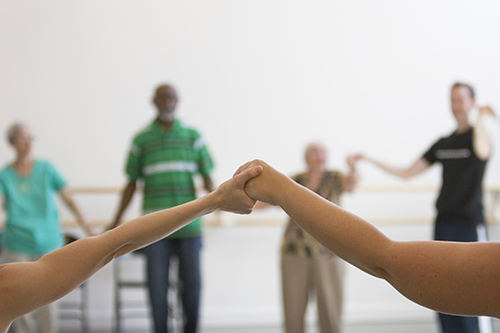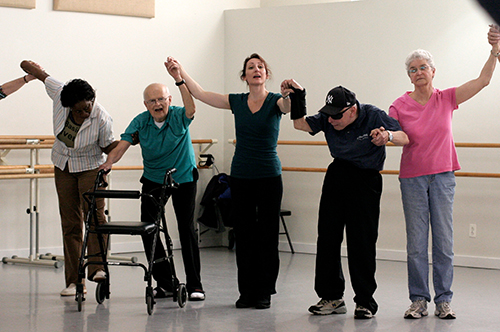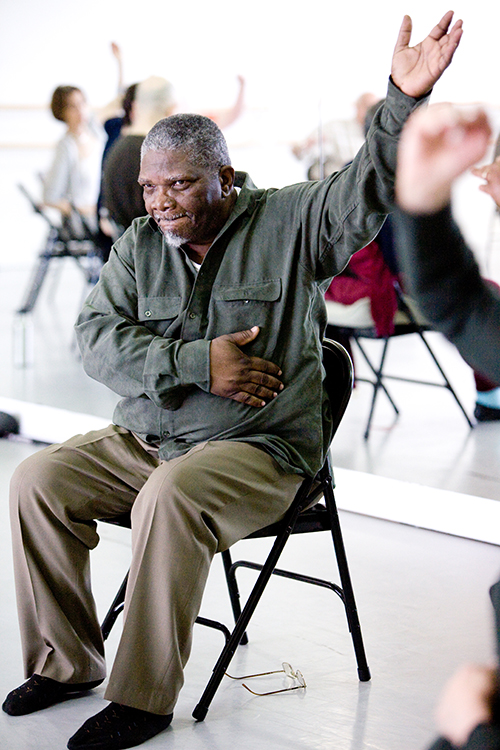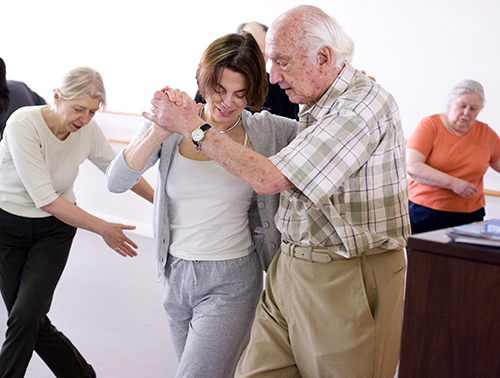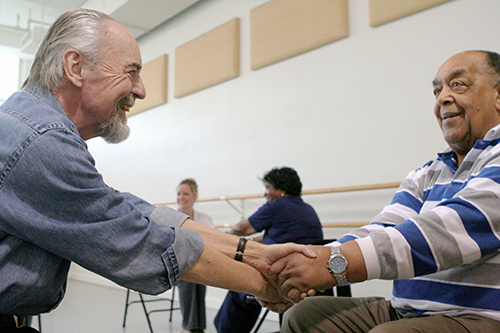Addressing Parkinson’s through Dance
AN INTERVIEW WITH DAVID LEVENTHAL
Born from the idea that people with Parkinson’s can benefit from the specific techniques and methods used by dancers to guide their own bodies and minds, Dance for PD® strives to increase coordination, balance, flexibility and strength through music and movement for people with Parkinson’s disease. David Leventhal, program director and founding teacher, shares the history and growth of Dance for PD, as well as why dance is a powerful tool to address Parkinson’s.
Photo by Johan Henckens
~~
How was Dance for Parkinson’s disease founded?
In 2001, Olie Westheimer, founder and executive director of the Brooklyn Parkinson Group, approached the Mark Morris Dance Group with the idea of a dance class for members of her group. Olie felt that people with Parkinson’s spent lots of time shuttling between doctors’ and therapists’ offices. She wanted people to do something positive, and she had a hunch that a dance class, taught by professional dancers, was that thing.
Before her retirement last year, Olie worked with the teachers to maintain the artistic focus and spirit of the program, which is, as it was on the first day, accompanied by live music. The idea is for professional teaching artists to integrate movement from modern, ballet, tap, folk, social dancing and choreographic repertoire to engage participants’ minds and bodies, and create an enjoyable environment for artistic exploration. Because Dance for PD focuses on the aesthetic movement of dance rather than acting as therapy, participants in class are encouraged to approach movement like dancers rather than as patients.
I think Olie’s hunch was exactly right; now I see a strong and consistent desire among persons with Parkinson’s around the world who’ve experienced the class to explore movement and regain a sense of confidence and grace in a creative, musical and social environment outside the traditional parameters of physical therapy and clinical rehabilitation. I taught the very first class, and worked with my colleagues John Heginbotham and Misty Owens to develop an approach and curriculum. Olie and members of BPG were instrumental in providing feedback, and that sense of community collaboration has been a consistent thread through the program’s development, wherever Dance for PD has taken root.
Photo by Amber Star Merkens
How are the classes structured?
In our flagship program in Brooklyn, we have anywhere between 35 to 55 participants in the class, along with two teachers and a musician. We start seated in chairs so participants can explore a range of movement and warm up their bodies without having to worry about balance. We integrate elements of ballet, modern, tap, folk dance, jazz and improvisation into the seated environment. The important thing here, I think, is to bring in a range of movement qualities and dynamics, and to create sequences that are diverse. For example, we’ll alternate an arm sweep with a sharp point across the room, or we’ll do a seated tap exercise so that people can explore all the different dynamic ways you can use your feet (which dancers take for granted, but other folks don’t really think about). We often try to bring in some narrative element to the exercises — either telling a story through physical gesture, or setting up a scene or scenario. After about 40 minutes of seated dancing, we try to spend the last 15 to 20 minutes moving across the floor in a variety of styles — and we always integrate those who wish to remain seated so that no one feels left out. We always end in a circle, usually with some kind of reverence.
Why focus on Parkinson’s disease, as opposed to other ailments that affect physical function?
Olie and the Parkinson’s community came to us, so we started developing approaches and materials that seemed to work particularly well for people with PD. I think there’s a special relationship between what dancers need to focus on in their training, and what people with Parkinson’s need to think about to manage the choreography of life. We both need to use a conscientious, imaginative, musical approach to transform challenging movement that is not (or no longer) automatic into something with a more seamless flow — and the training and mindset that dancers use to achieve this end up being a very powerful toolbox.
More and more physicians are emphasizing the value of combining physical activity, social interaction and cognitive stimulation — and Dance for PD classes provide that combination. However, we’ve had the pleasure of working with other populations, and we feel the Dance for PD approach and methodology can be adapted very effectively for people with other movement disorders, as well as those recovering from stroke. I also worked with a team at the Los Angeles VA hospital to create a program for veterans that was based closely on the Dance for PD method– and that program is still going strong six years later.
How do you believe dance benefits Parkinson’s patients in ways that other forms of exercise might not?
Dance and exercise both address balance and mobility, but dance addresses those issues by teaching people how to think about them strategically and consciously. Dancers spend their whole lives practicing ways to stay balanced and mobile and, in a good dance class, the teacher uses imagery, rhythm and technique to pass that information on. Dance also has a high adherence rate — because it’s often more enjoyable than a straight exercise program, people come back week after week to work on their skills. That’s why increasing numbers of people with Parkinson’s around the world recognize dance as an activity that addresses physical, emotional, cognitive and social needs very effectively, and does so in a fun and creative environment. For me, the cognitive components are particularly compelling because, in a dance class, you need to mirror, sequence, improvise, tell stories with your body, and attempt to achieve aesthetic, timing and spatial goals. When you compare the cognitive work that happens in a dance class with what happens on a bike or treadmill, you realize the dance class is on a very different level of thought and planning.
Photo by Rosalie O’Connor
Music also plays a critical role in learning and executing movement, and many participants tell us how dancing to music helps them achieve a state of fluidity and mobility that they may not find in other movement forms. There are now 37 peer-reviewed studies on the benefits of dance for people with Parkinson’s, so we’re starting to see support and interest from the research community as well.
Because Parkinson’s is degenerative and thus will get worse with time, how do you gauge success (since dancing won’t necessarily make Parkinson’s go away)?
We never focus on symptoms or on making symptoms go away. We only focus on the dance experience — and we try to help people become more confident, fluid and imaginative dancers. In that way, we see success all the time, and sometimes a participant’s transformation into a dancer is even more noticeable in someone with more impaired mobility. Even if someone isn’t moving very much, you can see the consciousness of their movement, the sense of focus they bring to how they move, rather than just the mechanics. And you can see this even if someone is moving within a very limited range.
We hear inspiring stories all the time that represent success. One man used the tap steps he learned in the Brooklyn class to help him connect with the floor when he got out of bed in the middle of the night. One woman recently told us that she was able to enjoy herself at a wedding because she danced all night — and she was able to do that because she developed confidence and stamina in our class. Sometimes, a smile speaks volumes. A couple in Louisville told me they enjoyed themselves more in the Dance for PD class than they had in the past five years. One of our Brooklyn students tells us that his doctor knows when he hasn’t been in class, because certain symptoms are worse.
Photo by Rosalie O’Connor
What directions do you see the organization expanding in the future?
The program is in more than 145 communities in 22 countries around the world. We are interested in further expansion, but only if it can be done sustainability in a way that the programs are led by knowledgeable, compassionate and well-trained teaching artists, and are set up using a collaborative model that ensures financial stability and reliability. (We don’t want a program that gets set up one year and then can’t support itself the next year).
Our At-Home DVD series features three DVDs — each DVD has a complete Dance for PD class that can be done in the comfort of one’s own home. The format of the DVDs allows people to learn material directly from a Dance for PD founding teacher, and then practice that material with the teacher and members of the Brooklyn Parkinson Group. We want people to feel, as much as they can, that they are joining us in the studio. In partnership with Canada’s National Ballet School (NBS), we’ve also started broadcasting a free monthly live stream from the Brooklyn and Toronto classes. These streamed classes are then archived and available through the Global Hub maintained by NBS, and they provide another way for people to engage with us at home. We want to expand this livestream program by adding other streaming partners.
We also want to focus our resources on deepening existing relationships to provide richer programming (performance opportunities, for example) and providing professional development opportunities for our network of teachers. We’ll also continue to explore and invest in technology to expand access to dance within the Parkinson’s community.
Photo by Amber Star Merkens
~~
For more information, visit danceforparkinsons.org.

